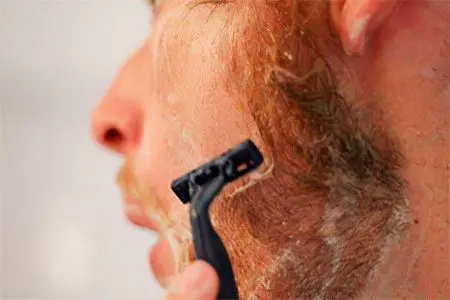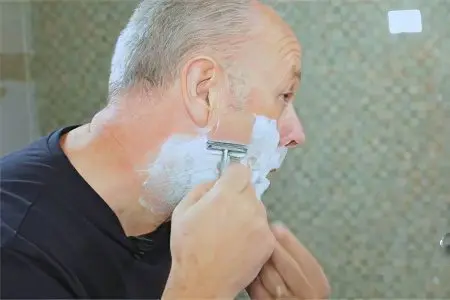Contents

Skin irritation after shaving is an inflammatory reaction of the epidermis to mechanical hair removal. Shaving is the most common way to eliminate unwanted hair on the face and body. It is used by both men and women.
Most often, machines are used for the shaving procedure, since using them is simple and safe. In addition, the hair removal procedure itself takes a few minutes and does not require special skills. However, ignorance of the basic rules for shaving hair, refusal to use auxiliary products (gels, balm foams, etc.) and the wrong technique for performing the procedure – all this leads to irritation on the skin.
Understanding that the skin of the face or body is irritated after shaving is not at all difficult. The most common sign of irritation is redness. In addition, acne, peeling areas may appear on the skin. An indispensable companion of skin irritation is itching of varying intensity.
Causes of skin irritation after shaving
The causes of skin irritation after shaving are varied, the main ones are:
Incorrect shaving technique.
Daily hair removal.
Improper skin care before shaving, during and after the procedure. The use of alkaline soaps, alcohol solutions that dry out the dermis.
Untimely replacement of razor blades or razors themselves.
Shave damaged, irritated or dry skin. You should not start the procedure if the skin is not previously moisturized. Any, even the most expensive and high-quality razor will irritate dry skin, scratch and cling to hairs.
Injury to the skin during shaving, followed by the entry of pathogenic bacteria into microscopic wounds. Infection of the skin can be very dangerous, as bacteria can cause inflammation and suppuration of the wound. Therefore, if after shaving the skin swells, becomes very painful, large blisters filled with pus appear on it, the body temperature rises, then it is necessary to seek medical help.
Rotary electric shavers can lead to skin irritation. Such devices are in very close contact with the skin, which leads to irritation. In addition, the bristles are not shaved at the root. Hair protrudes above the surface of the skin, touches the elements of clothing, bedding, which leads to irritation.
Prevention of skin irritation after shaving
Methods for preventing skin irritation after shaving depend on what exactly leads to such a reaction. Therefore, you need to consider them through the prism of the causes that cause unwanted inflammation:
Proper shaving technique

When shaving, you must adhere to a strictly defined direction. Movement should go from top to bottom, according to hair growth. Some areas may be shaved diagonally.
Do not press hard on the skin. Well, if you can pull it a little with the hand that remains free.
After every 2-3 movements, the machine should be rinsed under running water. The more blades on the razor, the faster they will become clogged with cut hairs, which will lead to a poor shave and provoke irritation.
If the hair being shaved is soft, then the razor should be rinsed with cold water. If the hair is hard, then the water jet should be warm.
Irritation in men most often occurs when shaving the chin and area above the upper lip. To reduce the likelihood of its occurrence, the skin should be steamed beforehand, as this procedure allows you to expand the pores. While shaving, the lips should be pressed tightly against the front teeth.
The fewer movements of the blade will be performed on one area of the skin, the less the risk of developing inflammation.
If there are ingrown hairs, then they should first be picked up with tweezers, and then shaved off with a gentle movement.
Shaving frequency and optimal time for the procedure
No matter how fast the hair grows, daily shaving will negatively affect the condition of the skin, and it will not be possible to prevent irritation. Therefore, you should take a break between hair removal procedures for at least one day.
The bikini area is best treated in the evening, so that it is possible to let the skin “breathe”. It is advisable not to dress for 20 minutes, and after this time it is good to powder the skin with baby powder.
In order for the skin of the face to recover, it is best to shave it before going to bed. During the night, the skin will calm down and even if irritation does occur, it will not be as pronounced as in the first hours after hair removal.
Skin care before shaving, during and after shaving
Moisturize your skin before shaving. To do this, you can use special creams. If for some reason this is not possible and you have to shave dry skin, then you should first powder it with talcum powder. You can also steam the skin by taking a hot shower or bath, or simply apply a towel soaked in warm water to it. Leave him
The gel provides a smoother glide of the machine over the skin, in comparison with shaving foam. It should be applied to the treated area 5 minutes before the procedure, which will make the bristles softer. Regular soap should not be used to create lather, as it is not able to provide optimal glide of the razor, and also dries the skin.
Shaving foam or other shaving product should be chosen according to the type of skin. On the packaging of any product there is a corresponding mark, which you need to focus on. If choosing a shaving product is difficult, then you should purchase one that has the inscription “for sensitive skin.”
You should also use different products for shaving the intimate area and for removing hair from the face. Most men’s gels and foams are not suitable for women’s thinner and more sensitive skin, so they will contribute to irritation.
After shaving, you need to rinse the skin with cool water, which will narrow the pores and soothe the dermis. It is strictly forbidden to rub the skin with a hard towel, you just need to get it wet.
You should not treat the skin after shaving with alcohol solutions, especially if it concerns the bikini area or armpits. It is better to use this recipe: you should grind 2 tablets of Acetylsalicylic acid into powder and add glycerin (2 tablespoons) to the resulting mixture. For disinfection, you can also use hydrogen peroxide or a solution of Chlorhexidine.
If there is no suitable product at hand, then after removing the hair, you can disinfect the skin with a roll-on deodorant, but not an antiperspirant.
You should not comb the redness that has appeared, in general, once again it is better not to touch the skin so as not to infect the infection.
[Video] BARBAROSSA – TOP 5 tips on how to get rid of irritation after shaving:









